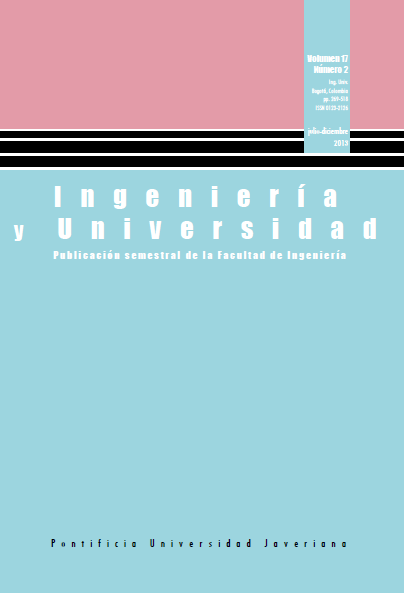Abstract
The algorithm proposed in this paper approaches to the angular speed by signals coming from an incremental encoder. This algorithm removes the oscillations that appear even at constant speed, when using the traditional algorithms, which are known as at fixed time and at fixed space. The key idea on the elimination of the oscillations is the synchronization between a signal every δ time and the pulses coming from the encoder. The most outstanding result in this paper says that the harmonic average between the output of the proposed algorithm and the output of a modification of this same algorithm turns out to have the smallest possible relative error. The relative error of the new algorithm is always smaller than half of what would be by using traditional algorithms, which shows that the algorithm is optimal. At the end of the article, and using real pulses from an encoder, some experiments were run in Matlab
D’ARCO, S.; PIEGARI, L. y RIVO, R. An Optimized Algorithm for Velocity Estimation Method for Motor Drives. Symposium on Diagnostics for Electric Machines, Power Electronics and Drivers. Atlanta, GA, USA, 2003, pp. 76-80.
HACHIYA, K. y OHMAE, T. Digital speed control system for a motor using two speed detection methods of an incremental encoder. Power Electronics and Applications, 2007 European Conference. Aalborg, Dinamarca, 2007, pp. 1-10.
HOANG H. y JEON J. An efficient approach to correct the signals and generate high-resolution quadrature pulses for magnetic encoders. IEEE Transactions on industrial electronics. 2011, vol. 58, núm. 8, pp. 3634-3646.
LIU, G. On velocity estimation using position measurements. American Control Conference, 2002. Proceedings of the 2002. 2002, vol. 2, pp. 1115-1120.
LYGOURAS, J.; PACHIDIS, T.; TARCHANIDIS, K., et al. Adaptive High-Performance Velocity Evaluation Based on a High-Resolution Time-to-Digital Converter. IEEE Transactions on Instrumentation and measurement. 2008, vol. 57, núm. 9, pp. 2035-2043.
MERRY, R.; MOLENGRAFT, R. y STEINBUCH, M. Error modeling and improved position estimation for optical incremental encoders by means of time stamping. Proceedings of the 2007 American Control Conference. New York City, USA, julio 11-13, 2007, pp. 3570-3575.
NANDAYAPA, M.; MITSANTISUK C.; y OHISHI K. High resolution position estimation for advanced motion control based on FPGA. IECON 2012 - 38th Annual Conference on IEEE Industrial Electronics Society. 2012, pp. 3808-3813.
NEGREA, C.; INCZE, I.; IMECS, M., et al. An improved speed identification method using incremental encoder in electric drives. IEEE International Conference on Automation Quality and Testing Robotics (AQTR). 2012, pp. 536-540.
PETRELLA, R. y TURSINI, M. An Embedded System for Position and Speed Measurement Adopting Incremental Encoders. IEEE Transactions on industry applications. 2008, vol. 44, núm. 5, pp. 1436-1444.
SU, Y.; ZHENG, C.; SUN, D., et al. A Simple Nonlinear Velocity Estimator for High-Performance Motion Control. IEEE Transactions on Industrial Electronics. 2005, vol. 52, núm. 4, pp. 1161-1169.
TSUJI, T.; HASHIMOTO, T.; KOBAYASHI, H., et al. Wide-Range Velocity Measurement Method for Motion Control. IEEE Transactions on industrial electronics. 2009, vol. 56, núm. 2, pp. 510-519.
VOLDÁN, J. Use encoder speed sensors for the calculation of torque moment. 13th International Carpathian Control Conference (ICCC). 2012, pp. 768-771.
This journal is registered under a Creative Commons Attribution 4.0 International Public License. Thus, this work may be reproduced, distributed, and publicly shared in digital format, as long as the names of the authors and Pontificia Universidad Javeriana are acknowledged. Others are allowed to quote, adapt, transform, auto-archive, republish, and create based on this material, for any purpose (even commercial ones), provided the authorship is duly acknowledged, a link to the original work is provided, and it is specified if changes have been made. Pontificia Universidad Javeriana does not hold the rights of published works and the authors are solely responsible for the contents of their works; they keep the moral, intellectual, privacy, and publicity rights.
Approving the intervention of the work (review, copy-editing, translation, layout) and the following outreach, are granted through an use license and not through an assignment of rights. This means the journal and Pontificia Universidad Javeriana cannot be held responsible for any ethical malpractice by the authors. As a consequence of the protection granted by the use license, the journal is not required to publish recantations or modify information already published, unless the errata stems from the editorial management process. Publishing contents in this journal does not generate royalties for contributors.


